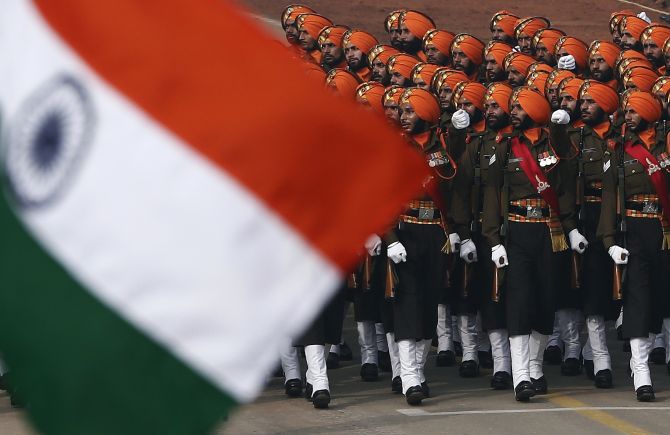 | « Back to article | Print this article |
Defence Minister Manohar Parrikar said on Thursday that the government has completed processes and will implement "one rank, one pension" for the armed forces soon.
"My ministry has completed all formalities and OROP will be implemented," Parrikar said at a function boycotted by two war veterans who were to be felicitated.
Here are some frequently asked questions about the scheme.

What is One Rank, One Pension?
The ‘one rank, one pension’ rule means that retired soldiers of the same rank and length of service will receive the same pension, regardless of when they retire.
As of now, the date of retirement determines the amount of pension. With each Pay Commission coming up with its recommendations every 10 years, the military veterans who retire early, receive less pension as compared to those who retired later with the same rank and length of service
Under OROP, a sepoy who retired in 1995, for instance, would get the same amount of pension as the one who retired in 1996.
Who will benefit from OROP?
Ex-servicemen drawing pensions will benefit from the OROP scheme, especially those who retired before 2006. Why? Because at present, pensioners who retired before 2006 draw less pension than their counterparts and even their juniors. The scheme will benefit all three services -- air force, navy and army.
How much will the OROP scheme cost the government?
The United Progressive Alliance government in their interim budget had announced an amount of Rs 500 crore for the scheme. However, NDA’s Finance Minister Arun Jaitley in his Budget announcement allotted Rs 1,000 crore for the scheme.
Why has there been so much delay in implementing OROP?
Officials within the ministry of defence have been against the implementation of OROP, citing financial, administrative and legal impediments.
In 2011, the Department of Ex-Servicemen Welfare of the MoD pointed out to a parliamentary committee that OROP was not feasible to implement since documents of military personnel are weeded out after 25 years -- which is not true.
In reality, the Pension Payment Orders of pensioners, which contain all relevant details such as the rank last held and the length of service, are retained during the lifetime of each pensioner and then during the lifetime of the family pensioner in case of his demise. Further, all these details are available in a document called 'Long Roll' which is maintained in perpetuity in terms of Regulation 592 of the Regulations for the Army.
Another reason given by those opposing the scheme was that “other employees” would also start demanding OROP.
When did OROP become a reality?
After several protests and demands, the Manmohan Singh government towards its fag-end agreed in principle to clear the scheme in 2013. Realising the importance of correcting the wrong, the Narendra Modi government and the prime minister himself gave renewed hope to the veterans by announcing the implementation of the OROP scheme “as soon as possible".
On April 9, Defence Minister Manohar Parrikar said, “All hurdles, including a political clearance on its financial implications, have been removed. Now the actual calculation and administrative details are being worked out. We are sure to get the scheme rolling in the next few weeks.”